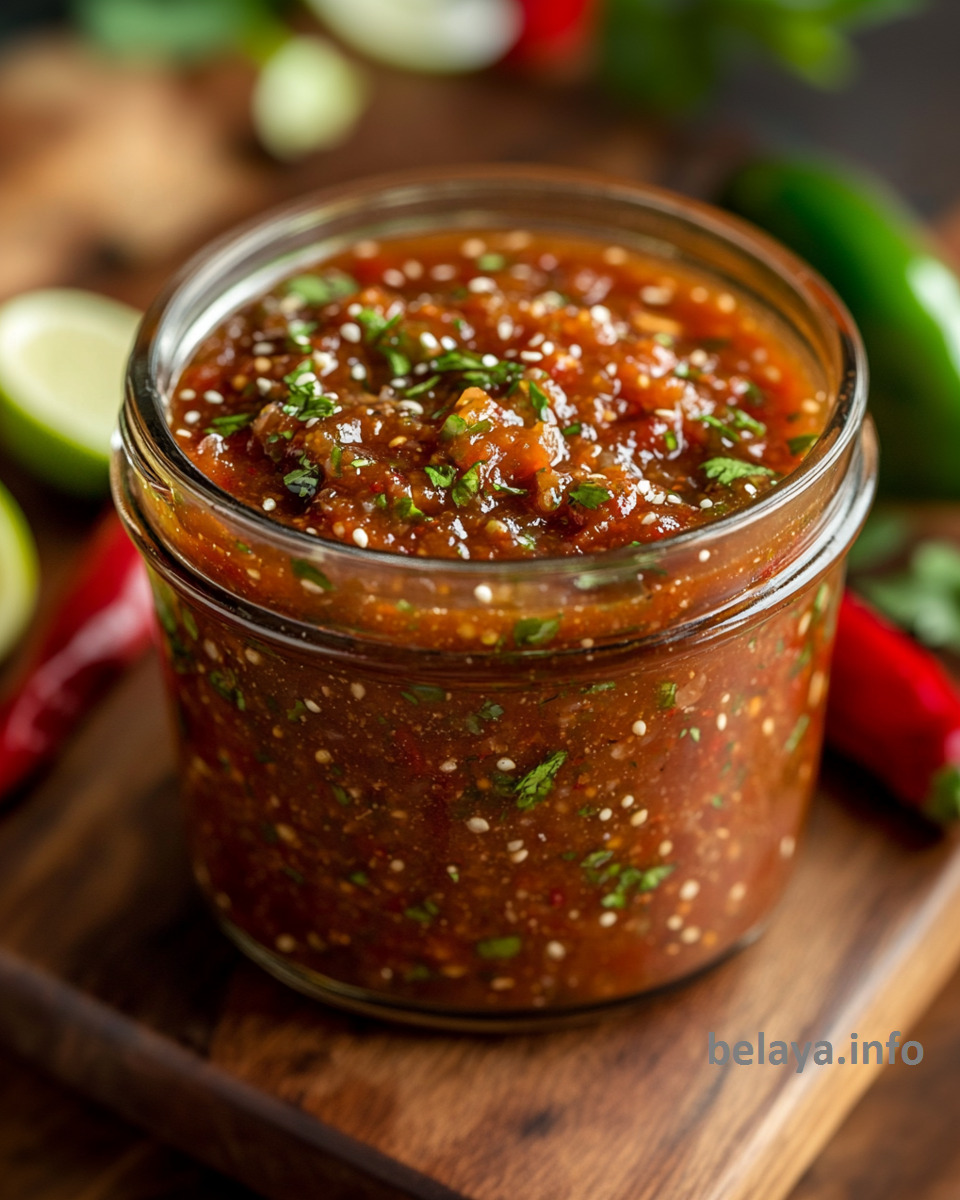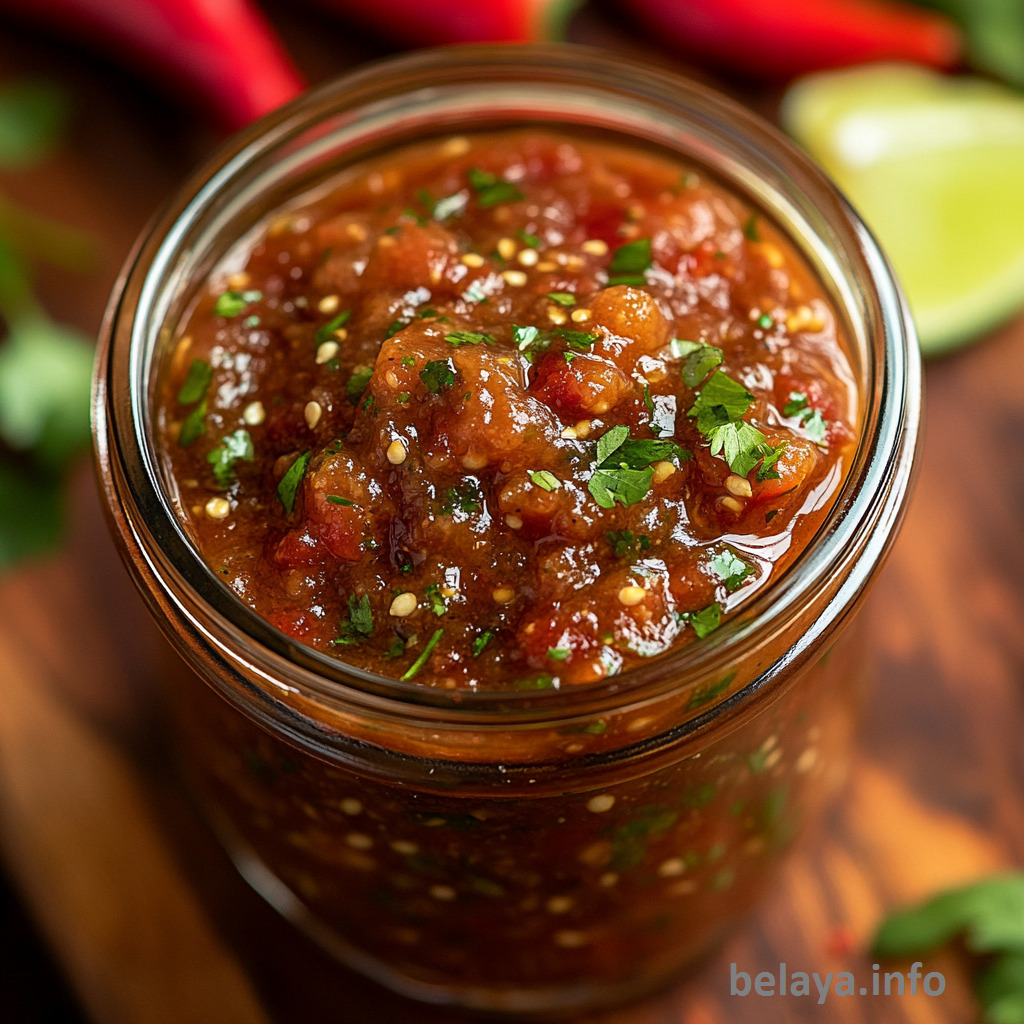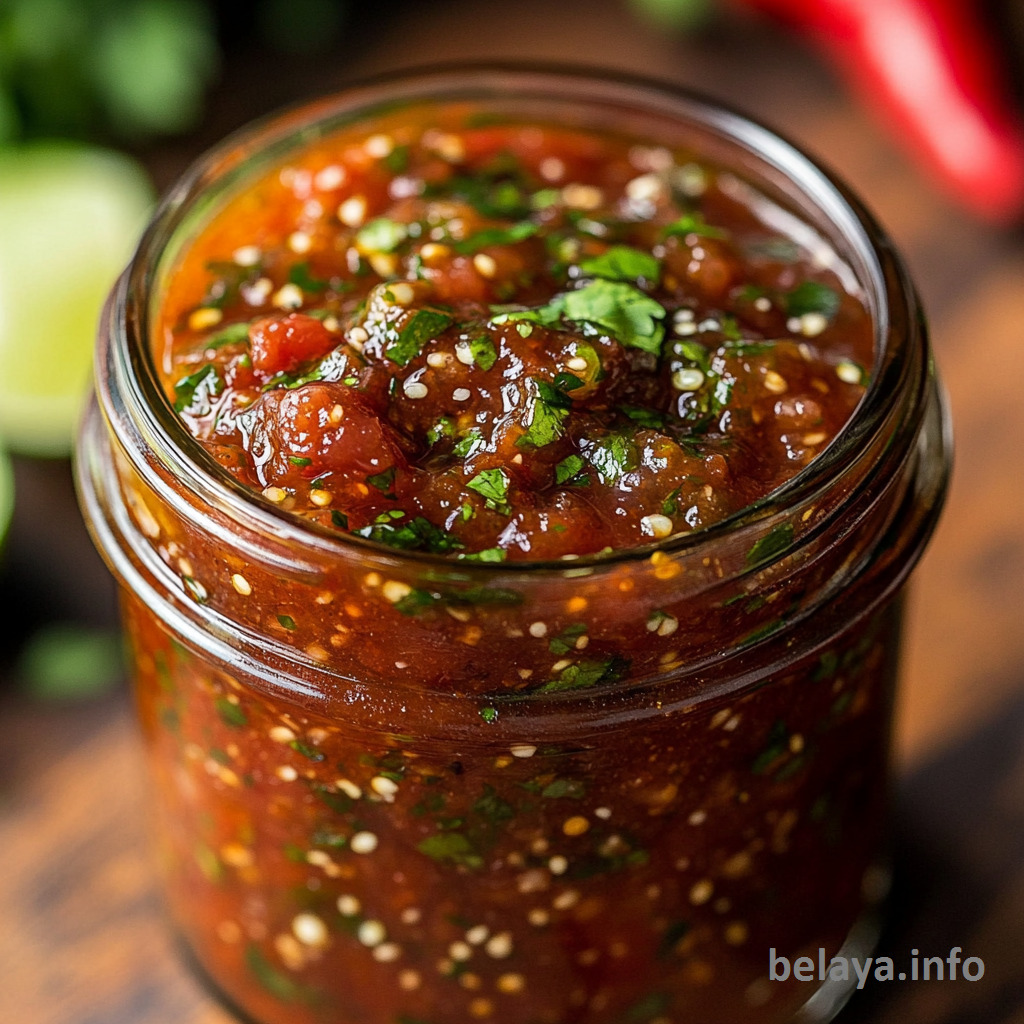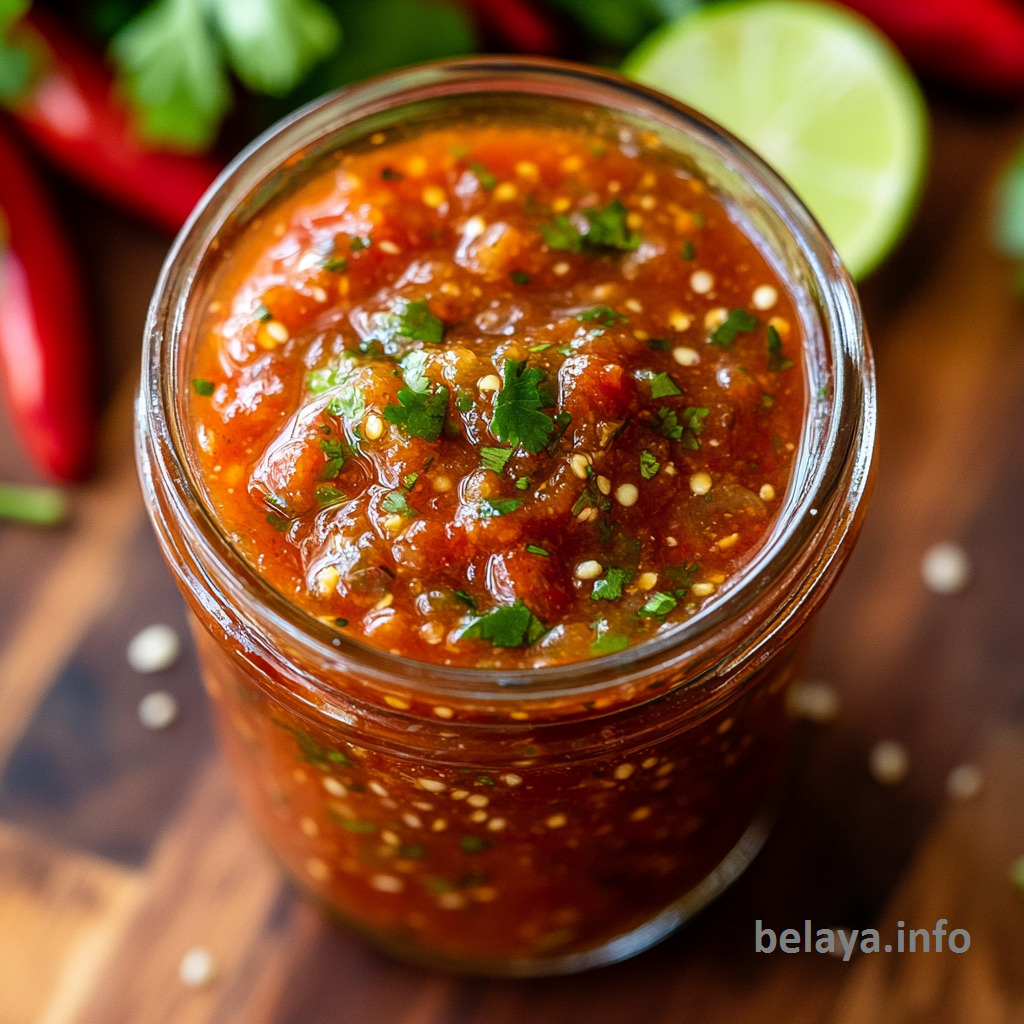Chile de Arbol Salsa
Chile de Árbol Salsa is a bold, fiery expression of Mexican culinary tradition—simple in ingredients, yet complex in character. Made with dried árbol chiles, roasted tomatoes, tomatillos, and a splash of lime, this salsa delivers a clean, sharp heat that lingers without overwhelming.
It’s not just about spice—it’s about balance: the smokiness of toasted chiles, the brightness of lime, and the tangy depth of tomatillos all come together in a smooth, deeply flavored condiment.
Whether used as a dip, a drizzle, or a cooking base, this salsa transforms any dish it touches, adding punch, soul, and unmistakable authenticity.

Why You’ll Love The Chile de Árbol Salsa Recipe:
Bold, authentic flavor: This salsa captures the essence of traditional Mexican cuisine—fiery, smoky, tangy, and vibrant—with just a few ingredients, offering a pure and powerful flavor experience.
Customizable heat: Using dried chile de árbol allows you to control the spice level by adjusting the amount or toasting time, making the salsa as bold or as balanced as you like.
Versatile application: It’s more than just a dip—it can elevate tacos, grilled meats, roasted vegetables, eggs, soups, or rice bowls. A spoonful transforms a simple dish into something memorable.
Depth from simple ingredients: The layering of garlic, charred tomatoes, tangy tomatillos, and lime juice creates a salsa that’s not just spicy, but complex—with smoky, acidic, and slightly sweet undertones.
Naturally healthy and clean: Made with whole, real-food ingredients and no preservatives, this salsa is vegan, gluten-free, and full of anti-inflammatory elements like garlic, chiles, and lime.
Quick to make, easy to store: It comes together in about 20 minutes and lasts well in the fridge, making it ideal for meal prep, weeknight meals, or hosting without stress.

Key Ingredients:
Dried chile de árbol is the soul of this salsa—small in size but intense in heat and flavor. When toasted, these chiles release a smoky, nutty aroma that forms the spicy backbone of the salsa, adding both warmth and complexity.
Tomatillos bring brightness and acidity that tame the chile’s fire. Their slightly citrusy tang cuts through the heat, providing balance and depth while anchoring the salsa in traditional Mexican flavor.
Plum tomatoes add sweetness, body, and a touch of richness to round out the sharpness of the other ingredients, softening the heat with a smooth, earthy undertone.
Fresh garlic enhances the savory base, offering a pungent, aromatic layer that deepens the overall flavor and adds a bold edge to the salsa.
Lime juice brings a burst of freshness and acidity, lifting the heavier, roasted elements and tying the flavors together with its sharp citrus snap.
Avocado oil helps toast the chiles evenly and carries the fat-soluble flavors throughout the salsa, adding a silky mouthfeel and subtle richness.

Expert Tips:
Toast chiles with precision: Toasting dried chile de árbol is essential to release their oils and deepen their flavor, but they burn quickly. Toast them over medium heat for just 2–3 minutes, stirring constantly. Burnt chiles turn bitter, so remove them from the pan as soon as they darken and become aromatic.
Balance the heat with acidity: The natural sharpness of tomatillos and lime juice isn’t just for brightness—it tames the fire of the chiles and creates a more rounded flavor. If the salsa is too hot, a little extra lime juice or a roasted tomato can mellow it without diluting the complexity.
Use ripe tomatillos: Choose firm, vibrant green tomatillos with tight husks. Overripe or pale tomatillos can taste bland or overly sour. Rinsing them well after husking removes the sticky residue that can affect the salsa’s clarity and texture.
Simmer for depth: After sautéing the vegetables and adding the broth, simmer until the liquid reduces and everything is very soft. This step concentrates the flavors and ensures a smooth, cohesive salsa when blended.
Blend for your purpose: A longer blend time gives you a silky, pourable salsa—ideal for drizzling over tacos or grilled meats. For dipping or spreading, pulse until thick and textured. Add broth or water a tablespoon at a time to reach your preferred consistency.
Chill for flavor development: Although optional, chilling the salsa for at least 1 hour allows the flavors to marry and mellow. The salsa becomes smoother, more balanced, and often even hotter as the chile’s oils infuse more fully.
Wear gloves when handling dried chiles: Even though they’re dry, chile de árbol can leave residual capsaicin on your fingers that can irritate your eyes or skin. Wearing gloves or washing hands thoroughly afterward is a smart precaution.

How to make Chile de Arbol Salsa
Ingredients:
2 tablespoons avocado oil
1 ounce dried arbol chilies, stems removed
1 teaspoon fresh minced garlic
2 quartered plum tomatoes
2 tomatillos, washed, husked, and halved
1/2 cup vegetable broth, or water
1/4 cup lime juice
1/2 teaspoon sea salt, or to taste
Instructions:
Step 1:
In a large skillet over medium heat, warm avocado oil.
Once hot, add dried arbol chilies and cook, stirring constantly, until color begins to deepen, about 2-3 minutes.
Step 2:
Add garlic, tomatoes, and tomatillos to skillet.
Continue to cook, stirring frequently, until garlic is fragrant and vegetables begin to soften, about another 2-3 minutes.
Step 3:
Pour vegetable broth into skillet.
If needed, use a spatula to gently scrape the bottom of the pan to loosen any stuck-on bits.
Bring mixture to a simmer and cook until liquid has evaporated and vegetables are soft, about 10-15 minutes.
Step 4:
Remove skillet from heat. Allow to cool for 5-10 minutes, then carefully pour contents into a food processor.
Add lime juice and season with sea salt.
Blend on high until smooth or desired consistency is reached, about 2-3 minutes.
Step 5:
Transfer salsa to a sealed container and chill in the refrigerator for at least 1 hour (optional).
Serve immediately as a dip, garnish, or ingredient for another recipe.

Important Notes When Making Chile de Arbol Salsa
Chile intensity varies by batch: Dried chile de árbol can differ widely in heat depending on where and how they were grown. Always taste a small piece before using the full amount—you can adjust the quantity to suit your preferred spice level without sacrificing flavor.
Proper toasting makes or breaks the salsa: Toasting the chiles is not just a flavor booster—it’s essential. However, the line between perfectly toasted and burnt is thin. Burned chiles will turn the entire salsa bitter, so monitor the heat closely and stir continuously.
Simmering transforms flavor: Allowing the tomatoes, tomatillos, garlic, and chiles to simmer in broth doesn’t just soften the ingredients—it also melds their flavors, intensifies the depth, and reduces harsh edges. Skipping this step can lead to a raw or overly acidic result.
Blending time affects heat distribution: The longer you blend, the more evenly the chile oils are dispersed, which can make the salsa feel spicier even if no extra chiles are added. Stop blending early if you want a chunkier texture and more defined ingredients; blend longer for a smooth, unified heat.
Salt and lime are your finishing tools: These two ingredients balance everything. Lime juice cuts richness and brightens the salsa, while salt unlocks hidden layers of flavor. Always taste after blending and adjust both as needed—just a pinch more can make a noticeable difference.
Resting the salsa enhances complexity: While this salsa can be served right away, resting it in the refrigerator allows the flavors to deepen, the chile heat to mellow and spread, and the overall profile to become more cohesive and rounded.
A little goes a long way: This salsa is meant to complement, not overwhelm. Use it to enhance, not dominate, the dishes it accompanies. Even a small spoonful brings a punch of character, making it ideal for layering flavors without overpowering them.

How to Enjoy Chile de Árbol Salsa After Making:
As a classic table salsa:
Serve it in a small bowl alongside tacos, burritos, quesadillas, or tamales. Just a spoonful elevates each bite with smoky heat and tangy brightness, enhancing without overwhelming.
Drizzle over grilled meats and seafood:
The vibrant heat pairs beautifully with carne asada, grilled chicken, shrimp, or fish tacos. A light drizzle cuts through richness and adds bold contrast to charred, savory proteins.
Stir into soups and stews:
Add depth and fire to pozole, albondigas (meatball soup), or tortilla soup by mixing in a spoonful of the salsa before serving. It brings warmth and complexity without the need for extra spices.
Use as a marinade booster:
Blend a few tablespoons into marinades for pork, beef, or tofu to infuse them with spicy, smoky notes. The acidity from lime juice and tomatillos helps tenderize while layering in flavor.
Pair with breakfast dishes:
Spoon it over eggs, chilaquiles, breakfast burritos, or avocado toast. Its bold heat contrasts perfectly with creamy textures and runny yolks.
As a dipping salsa:
Serve chilled with tortilla chips, roasted sweet potatoes, or grilled vegetables. The salsa’s punchy flavor and smooth texture make it perfect for casual snacking or elegant appetizers.
Mix into rice or beans:
Stir a tablespoon or two into Mexican rice, refried beans, or black beans for a subtle heat upgrade. It’s a great way to unify a meal without creating a new dish.
Keep it on hand:
Store in an airtight container in the fridge for up to 1 week. It deepens in flavor over time, making it a versatile go-to condiment for quick meals, leftovers, or last-minute flavor fixes.

Nutrition Information:
Calories: 392 kcal | Total Fat: 31 g | Saturated Fat: 4 g | Trans Fat: 0 g | Cholesterol: 0 mg | Sodium: 1428 mg | Total Carbohydrate: 31 g | Dietary Fiber: 13 g | Sugars: 12 g | Protein: 5 g
Frequently Asked Questions:
Can I adjust the spiciness of the salsa?
Yes, you can control the heat by adjusting the number of dried arbol chilies you use.
More chilies will make the salsa hotter, while fewer will make it milder.
Can I use fresh tomatoes instead of plum tomatoes?
Yes, you can substitute plum tomatoes with fresh tomatoes.
Adjust the quantity based on the size and juiciness of the tomatoes.
How long does it take to make this salsa?
It typically takes about 30-40 minutes from start to finish, including preparation and cooking time.
Can I make this salsa ahead of time?
Yes, you can make the salsa ahead of time.
It stores well in the refrigerator for up to one week in a sealed container.
Is it necessary to roast the tomatoes and tomatillos?
Roasting enhances the flavor of the tomatoes and tomatillos, giving the salsa a richer taste.
However, if you prefer a fresher flavor, you can skip this step.
What can I serve this salsa with?
This salsa is versatile and can be served as a dip with tortilla chips, as a topping for tacos, grilled meats, or even stirred into soups and stews for added flavor.
How spicy is Chile de Arbol salsa?
It can be quite spicy depending on the number of arbol chilies used.
It tends to be hotter than regular salsa due to the nature of arbol chilies.
Can I freeze this salsa?
Yes, you can freeze this salsa in airtight containers or freezer bags for up to 3 months.
Thaw it overnight in the refrigerator before serving.
What’s the best way to adjust the consistency of the salsa?
If the salsa is too thick, you can add a little water or vegetable broth while blending until you reach the desired consistency.
Can I use different types of chilies instead of arbol chilies?
Yes, you can experiment with different dried chilies based on your preference.
However, the flavor and spiciness may vary.